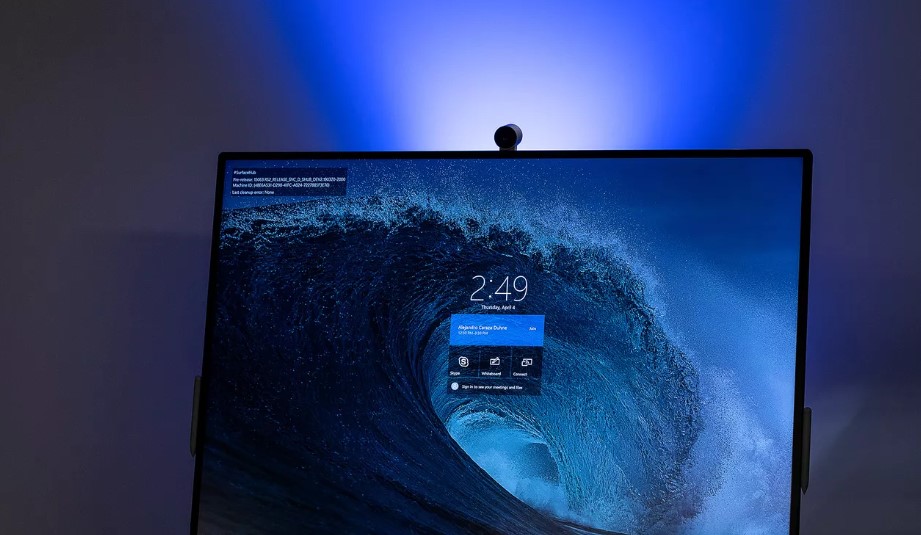
Microsoft has been obsessed with giant touchscreen displays for years. Every once in a while, the company creates a future vision video where everyone in an office is doing their work collaboratively on huge displays mounted on walls. It seems really far out there, but that future is now starting to arrive with the Surface Hub 2.
At the most basic level, it’s a giant conference room display that will ship in both 50- and 85-inch versions, but Microsoft is really pitching this as something far more. It’s really designed for meeting rooms of the future, where people are expected to collaborate using the screen, rather than just sit and watch a presentation. It certainly doesn’t look like your typical boring conference room TV that you’d see in a meeting room today.
“The unique thing about the Hub, in comparison with the rest of the Surface line, is that it’s not a personal computer,” explains Microsoft’s hardware design chief Ralf Groene, in an interview with The Verge. “It’s really a computer that belongs to a space.”
I traveled to Microsoft’s campus earlier this month to get a closer look at the Surface Hub 2, all of its optional extras, and the special modular processor cartridge that Microsoft has created to upgrade its hardware in the coming years. The Surface Hub 2S (yes, 2S is the official model number) will be available in June for $8,999.99, and if you want all the optional extras then it’ll run to nearly $12,000.
The future doesn’t come cheap.
HARDWARE AND SPECS
Surface Hub 2S specs
- 50-inch 3:2 IPS 60Hz PixelSense display (3840 x 2560)
- Intel 8th Gen Core i5 processor
- Front-facing three-way stereo speakers
- 8GB DDR4 RAM
- 128GB M.2 solid state drive (SSD)
- Wi-Fi / Ethernet port
- Weighs 61.6 pounds (28 kg)
- Measures 29.2 x 43.2 x 3.0 inches
It’s fair to say that the Surface Hub 2 is a beautifully designed piece of hardware. Compared to the original Surface Hub, it now looks and feels like real Surface hardware, and it’s far more striking than competitors like Google’s Jamboard.
Microsoft has opted for a 50-inch display (3840 x 2560 pixels) with the typical 3:2 Surface aspect ratio, compared to the 55-inch 16:9 panel that the company used on the original Surface Hub. The new aspect ratio means you’ll eventually be able to rotate this display for a portrait mode that’s ideal for conference calls, and it also gives you more vertical space for drawing, presenting, or viewing documents.
Compared to the original, the bezels are a lot thinner — 15.5mm to be precise — and Microsoft has done some work to improve the screen bonding for the stylus input and to improve the glare you might find on typical conference room displays.
You’ll be able to mount it on a wall, or use a stand to wheel it around to conference rooms or out into open-plan office spaces. Microsoft has worked with Steelcase to design the stand and wall mounts, and they’re both available separately at $1,449.99 for the stand and $249 for the wall mount.
There’s even a battery you can slot into the case of the stand that gives you around two hours of battery life on the go. You can then seamlessly unplug the Surface just like you would a laptop, and then wheel it into a meeting room or elsewhere. The battery expansion, like the stand, is sold separately for $1,400.
Microsoft has also built a dedicated 4K camera for the Surface Hub 2. It’s powered by USB-C, and it can be detached from the top to mount it with magnets to the side of the display. Because the Surface Hub 2 is designed to be wheeled around, Microsoft has even created a special snapback mechanism for the camera so if you crash it into a doorway, the camera won’t get sheared off.
Because this is actually a full-fledged PC and not just a big screen, Microsoft has a whole host of hardware inside. There’s an Intel 8th Gen Core i5 processor, 8GB of RAM, a 128GB M.2 SSD, and Intel’s UHD Graphics 620 integrated GPU. That means there’s a bunch of PC ports, too: a single standard USB-A port, a USB-C port, Gigabit Ethernet, HDMI video in, and Mini DisplayPort out. You’ll be able to connect devices up to this to use it as a monitor, and Microsoft is even planning to sell it separately as just a monitor without all the PC hardware inside, but the company isn’t announcing pricing for that model just yet.
The most interesting aspect of all this PC hardware is how Microsoft plans to let Surface Hub 2 owners upgrade the device over time. A Surface Hub 2X processor cartridge will be available next year, that will include an upgraded GPU to enable businesses to tile up to four of these displays together. This upgrade cartridge holds the processor, RAM, and GPU inside — basically the entire computer save for storage — and you’ll be able to slot it into the back of the Surface Hub 2.
This processor cartridge will also enable some of the more interesting software changes that Microsoft is making to this device, including the ability to rotate the display. We’ve seen Microsoft demonstrate this display rotation, and it looks far smoother than what currently exists in Windows 10 today. Microsoft isn’t announcing pricing or exact availability for the upgrade cartridge just yet, so we’ll have to see how it compares to the Hub 2’s price later on.
SOFTWARE AND MEETING ROOMS
Most of the more interesting software parts to the Surface Hub 2 won’t arrive until next year, so I wasn’t able to try any of them just yet. The Surface Hub 2 will ship in June with the same modified version of Windows 10 (Team) that is currently available on original Surface Hub machines. Microsoft says this is because businesses want to buy the new hardware and have budget plans years out, but it’s also likely because the software isn’t ready just yet.
Still, all the typical apps you’d expect to find on a Surface Hub are here, but it’s limited to Microsoft’s Universal Windows Platform apps (UWP). There’s an impressive Whiteboard app that will tidy up your handwriting automatically that works across Windows 10, iOS, Android, and the web so anyone can jump in and join a Whiteboard session. Microsoft Teams is also here for conference calls, and the usual Office apps like Word, PowerPoint, and Excel. You can log in like you would any Windows 10 PC, and access OneDrive documents you just worked on and hold a meeting via Skype for Business or Microsoft Teams.
If your business is all-in on Office 365, like many are, then this feels like a natural companion. The Surface Hub 2 feels like a fast PC, but it’s optimized for touch and stylus input on a bigger display. Being able to wheel it around an office could make for some more interesting meetings than you’re probably used to. But the really impressive parts of the Surface Hub 2 aren’t coming until later.
There’s screen rotation, tiling of up to four of the 50-inch versions side by side, and some clever ways to let multiple people use the Surface Hub 2. Microsoft has shown how two people will be able to log into a Surface Hub 2 at the same time using a fingerprint reader, and access both of their individual OneDrive documents to collaborate on or share in a meeting. The hardware certainly makes it easier to work more collaboratively, but it’s these software changes that will further transform this into a device for the future of meetings.
THE FUTURE ALL RELIES ON THE CARTRIDGE
“It’s very capable, the technology is amazing, but I think what it does to people collaborating is way more exciting than the industrial design,” says Groene. That might be true, but it’s a wait and see game right now. Until the 2X upgrade arrives, it’s really hard to tell how much of a difference the Surface Hub 2 will make to meeting rooms.
The hardware is undoubtedly impressive: Microsoft has made the Surface Hub 2 a lot more portable and mobile with its hardware choices, and that alone will naturally improve meetings and collaboration in offices.
It’s the software that will define this device’s true potential, and a lot of that is merely a promise right now. Microsoft has been working on its software update to the hub for months now, and it’s all part of a larger Windows Core OS (WCOS) effort inside Microsoft to modularize its operating system to run as clever modes on clever hardware.
Microsoft has been building WCOS and its Composable Shell (C-Shell) for years, and both efforts will allow Windows to run on new hardware, like the Surface Hub 2. It should make Windows more flexible for different screen sizes, and even hardware like a rumored “pocketable” Surface device with dual displays, or flexible and foldable displays that are emerging in the smartphone space.
While the current modified version of Windows 10 for the Hub 2 won’t run traditional (win32) desktop apps, Microsoft tells me it’s looking at allowing these traditional desktop apps to run on the Surface Hub 2X.
Until the 2X cartridge arrives in 2020, businesses are being offered a glimpse at the future with hardware that should get better with age thanks to a more modular design and software improvements. That’s an unusual proposition these days, but Microsoft is expecting businesses to pay the steep $8,999.99 price if they want a piece of the company’s future promises.
























